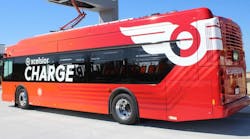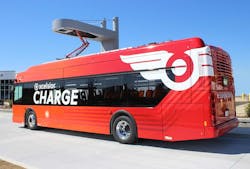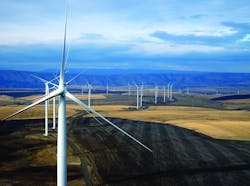Portland’s New Electric Buses Recharge Using Renewable Wind Energy
New battery-electric transit buses going into service in Portland, Ore. will recharge using power entirely obtained from renewable wind energy. Public transport operator TriMet (Tri-County Metropolitan Transportation District of Oregon) has received its first zero-emission Xcelsior CHARGE bus (Fig. 1) as part of a pilot test aimed at evaluating the behavior of electric buses under real-world conditions. The buses are manufactured by New Flyer, a U.S.-based subsidiary of the NFI Group of Canada, and will be manufactured at NFI’s Alabama facility.
1. An Xcelsior CHARGE bus at a recharging station. In Portland, energy for recharging will come from PGE’s Clean Wind program. (Source: New Flyer)
The pilot bus will be joined by four additional Xcelsior CHARGE buses this summer, creating an all-electric bus route. The buses will reduce greenhouse gas emissions by about 100 to 140 tons per year compared to a 40-ft. diesel bus and about 75 tons per year compared to TriMet’s eight diesel-hybrid buses.
Motors, Subsystems, and Accessories
The Xcelsior CHARGE bus employs direct-drive electric motors. No transmission is required, reducing cost, weight, maintenance and propulsion complexity. Regenerative braking is used while decelerating, recharging the batteries, reducing energy consumption, and extending range.
All on-board subsystems and accessories, e.g., air conditioning compressors, are electrically driven. The dc power is converted to ac power and supplied to each of these major systems separately. The bus also has a converter to supply 24-V dc power for power steering, interior fans, lights, electric doors, and other accessories. Electrically driven accessories mean fewer belts, fewer filters, and less fluids, all of which are routine maintenance items on conventional buses.
The buses will operate between the Sunset Transit Center and Washington Square Transit Center, with depot chargers installed at TriMet’s Merlo Operating Facility and an on-route charger installed at the Sunset Transit Center to recharge batteries each round trip. In all, TriMet has partnered with Portland General Electric (PGE) to purchase, own, and maintain six ABB chargers and related infrastructure. This includes a 450-kW en-route charger and 150-kW sequential bus depot chargers.
ABB’s HVC-Opportunity charging product offers high-power automated charging for both single- and double-deck electric buses from any manufacturer in as little as three to six minutes by using a pantograph coming down from the infrastructure. The company’s EV charging solutions connect chargers to the Microsoft Azure cloud-based platform. The TriMet chargers will be operated and maintained with the help of ABB's 24/7 managed network operations center.
The five buses will be deployed on a route operating from 5 a.m. to 11 p.m. TriMet will run the 40-passenger Xcelsior CHARGE bus on a route that covers 13 miles and 700 feet in elevation change. According to TriMet, approximately 59% of its bus routes are compatible with depot-charging technology (assuming a “real-world” range of 150 miles).
It’s in the Wind
The TriMet buses are believed to be the first wind-powered vehicles used in mass public transit in the United States. Energy for recharging will come from PGE’s Clean Wind program. The company operates two wind farms. Biglow Canyon Wind Farm, near Wasco in Sherman County, Ore. was completed in 2010 and has a total installed capacity of 450 MW (Fig. 2). Given the variability of wind power, the plant produces an average of around 150 MW.
2. The Biglow Canyon Wind Farm has a total installed capacity of 450 MW. (Source: PGE)
PGE’s second fully owned and operated wind farm is the Tucannon River Wind Farm, on 20,000 acres near Dayton, Wash. Tucannon, which was completed in December 2014, has a total installed capacity of 267 MW and produces an average of about 101 MW.
TriMet has the 11th largest bus fleet in the U.S. It provides over 97 million trips per year in Portland and surrounding areas, operating 658 buses, the vast majority of which (97%) are standard 40-ft. diesel buses. The company plans to convert its full fleet to electricity by 2040.




